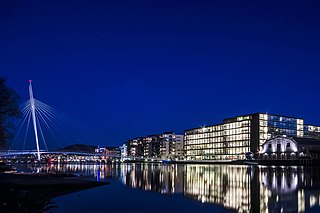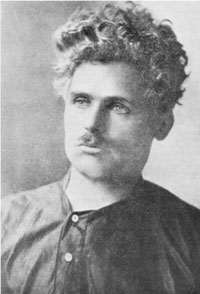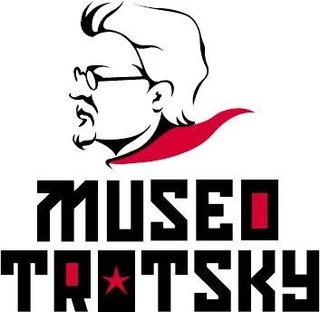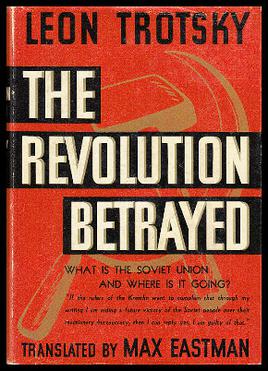
Lev Davidovich Bronstein, better known as Leon Trotsky, was a Russian revolutionary, Soviet politician, journalist, political theorist and founder of the Red Army. He was a central figure in the October Revolution, Russian Civil War, and the establishment of the Soviet Union. Alongside Vladimir Lenin, Trotsky was widely considered the most prominent Soviet figure and his de facto, second-in-command during the early years of the Russian Soviet Republic. Ideologically a Marxist and a Leninist, Trotsky's thought and writings inspired a school of Marxism known as Trotskyism.

Drammen is a city and municipality in Viken, Norway. The port and river city of Drammen is centrally located in the south-eastern and most populated part of Norway. Drammen municipality also includes smaller towns and villages such as Konnerud, Svelvik, Mjøndalen and Skoger.
Max Shachtman was an American Marxist theorist. He went from being an associate of Leon Trotsky to a social democrat and mentor of senior assistants to AFL–CIO President George Meany.
Lev Lvovich Sedov was the first son of the Soviet communist leader Leon Trotsky and his second wife Natalia Sedova. He was born when his father was in prison facing life imprisonment for having participated in the Revolution of 1905.

Natalia Ivanovna Sedova is best known as the second wife of Leon Trotsky, the Russian revolutionary. She was also an active revolutionary and wrote on cultural matters pertaining to Marxism.

Grandizo Munis was a Spanish Trotskyist politician. He is considered to have become a left communist following his break with the Fourth International.

Johan Nordahl Brun Grieg was a Norwegian poet, novelist, dramatist, journalist and political activist. He was a popular author and a controversial public figure. He served in World War II as a war correspondent and was killed while on a bombing mission to Berlin.
The International Revolutionary Marxist Centre was an international association of left-socialist parties. The member-parties rejected both mainstream social democracy and the Third International.

The Revolutionary Socialist Party was a Dutch socialist political party, that has been variously characterized as Trotskyite and syndicalist. In 1935 it merged with the Independent Socialist Party (OSP) to form the Revolutionary Socialist Workers' Party, but most of the former OSP members left the united party the same year. Henk Sneevliet was the RSP/RSAP's undisputed leader throughout its existence, as well as its only Representative.
Sergei Lvovich Sedov was a Soviet engineer and scientist, the son of Leon Trotsky, and was killed in the Great Purge.

Zinaida Lvovna Volkova was a Russian Marxist. She was Leon Trotsky's first daughter by his first wife, Aleksandra Sokolovskaya, a Marxist from Nikolaev (Ukraine). She was raised by her aunt Yelizaveta, sister of Trotsky, after their parents divorced. Her younger sister, Nina, stayed with her mother.

Georgy (Yury) Leonidovich Pyatakov was a Russian Bolshevik revolutionary, leader of the Bolsheviks and a key Soviet politician during and after the 1917 Russian Revolution. Pyatakov was considered by contemporaries to be one of the early communist state's best economic administrators, but with poor political judgement.

Timofei Vladimirovich Sapronov was a Russian revolutionary, Old Bolshevik and socialist militant who was one of the leaders of the Left Opposition in the Communist Party of the Soviet Union.

The Leon Trotsky House Museum, Trotsky Museum, or Trotsky House Museum, is a museum honoring Leon Trotsky and an organization that works to promote political asylum, located in the Coyoacán neighborhood of Mexico City. Its official name is Instituto del Derecho de Asilo - Museo Casa de León Trotsky.

Lev Borisovich Kamenev was a Bolshevik revolutionary and a prominent Soviet politician.

Alexei Ivanovich Rykov was a Russian Bolshevik revolutionary and a Soviet politician and statesman, most prominent as premier of Russia and the Soviet Union from 1924 to 1929 and 1924 to 1930 respectively. He was one of the accused in Joseph Stalin's show trials during the Great Purge.
The Moscow trials were a series of show trials held by the Soviet Union between 1936 and 1938 at the instigation of Joseph Stalin. They were nominally directed against "Trotskyists" and members of "Right Opposition" of the Communist Party of the Soviet Union. At the time the three Moscow trials were given extravagant titles:
- The "Case of the Trotskyite–Zinovievite Terrorist Center" ;
- The "Case of the Anti-Soviet Trotskyist Center" ; and
- The "Case of the Anti-Soviet 'Bloc of Rightists and Trotskyites'".

The Revolution Betrayed: What Is the Soviet Union and Where Is It Going? is a book published in 1936 by the exiled Soviet Bolshevik leader Leon Trotsky. This work analyzed and criticized the course of historical development in the Soviet Union following the death of Vladimir Lenin in 1924 and is regarded as Trotsky's primary work dealing with the nature of Stalinism. The book was written by Trotsky during his exile in Norway and was originally translated into Spanish by Victor Serge. The most widely available English translation is by Max Eastman.
Joseph Leroy Hansen was an American Trotskyist and leading figure in the Socialist Workers Party.

The following is a chronological list of books by Leon Trotsky, a Marxist theoretician, including hardcover and paperback books and pamphlets published during his life and posthumously during the years immediately following his assassination in the summer of 1940. Included are the original Russian or German language titles and publication information, as well as the name and publication information of the first English language edition.













